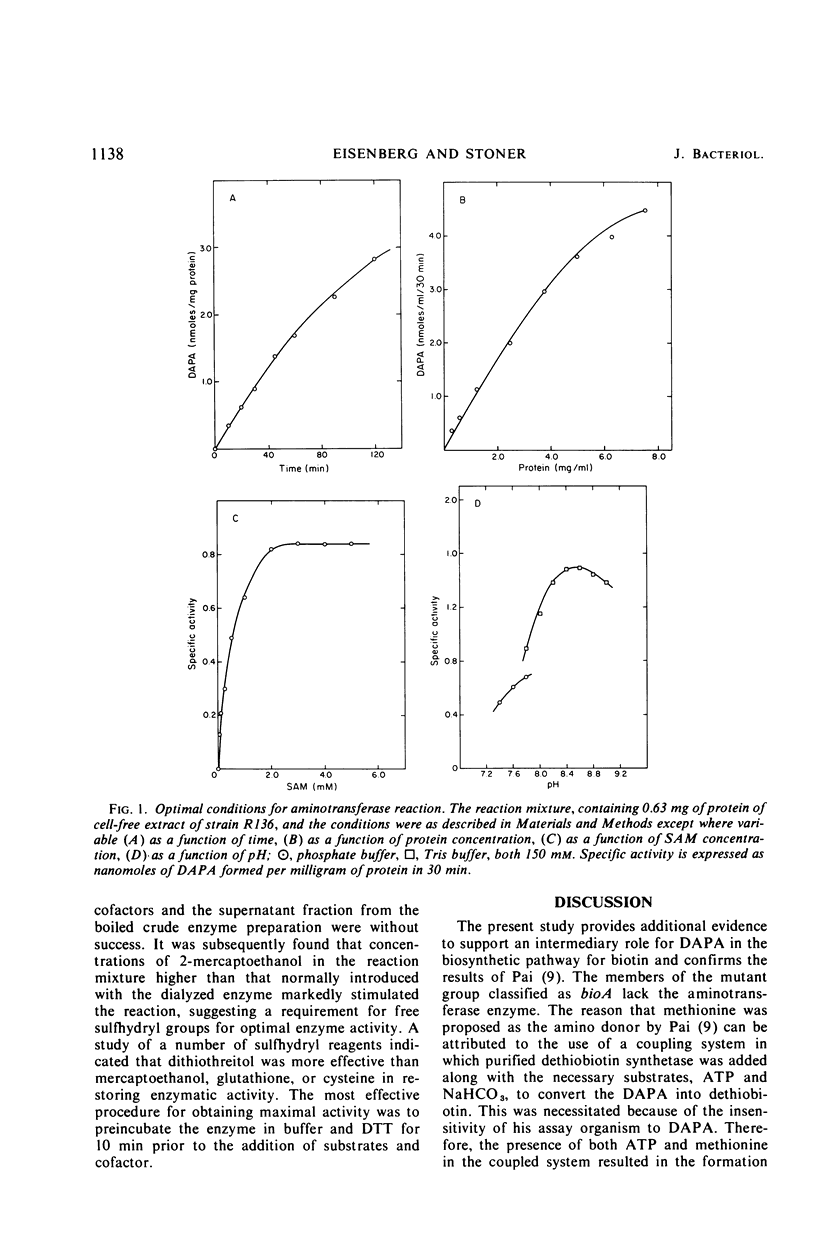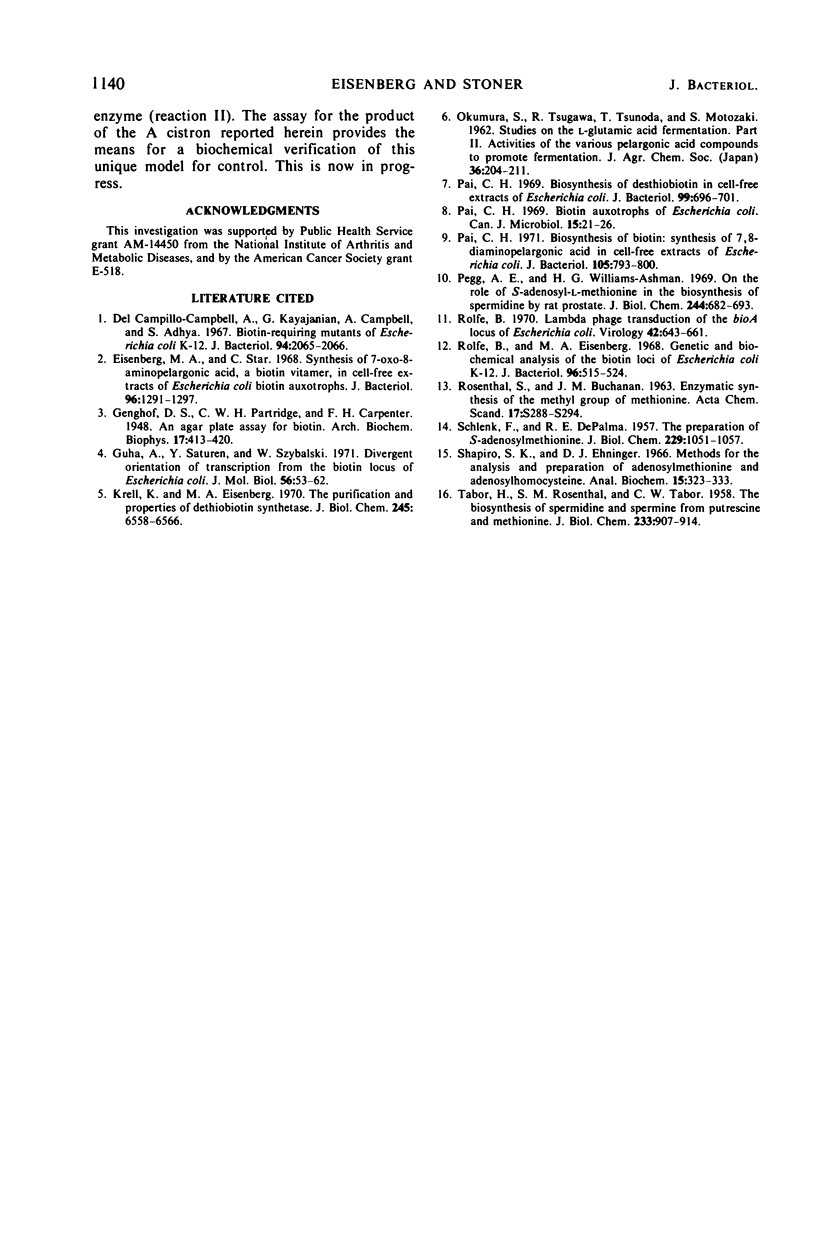Abstract
Resting cells of Escherichia coli strain D302(bioD302) can synthesize 7,8-diaminopelargonic acid from 7-keto-8-aminopelargonic acid. The product of this aminotransferase reaction has been identified by paper chromatography and electrophoresis. Glucose enhances the vitamer yield twofold. Of the 19 amino acids tested as amino donors, only methionine proved to be significantly stimulatory. In cell-free extracts, however, methionine was completely inactive unless both adenosine triphosphate (ATP) and Mg2+ were present. S-Adenosyl-l-methionine (SAM) was about 10 times more effective than methionine, ATP, and Mg2+. The optimal conditions for the reaction were determined, and substrate inhibition was found for 7-keto-8-aminopelargonic acid. It has been possible to eliminate certain impurities as amino donors in the commercial preparation of SAM and those that may arise in enzymatic reactions in which SAM is a substrate. The direct participation of SAM in the aminotransferase reaction seems a likely possibility.
Full text
PDF





Selected References
These references are in PubMed. This may not be the complete list of references from this article.
- Del Campillo-Campbell A., Kayajanian G., Campbell A., Adhya S. Biotin-requiring mutants of Escherichia coli K-12. J Bacteriol. 1967 Dec;94(6):2065–2066. doi: 10.1128/jb.94.6.2065-2066.1967. [DOI] [PMC free article] [PubMed] [Google Scholar]
- Eisenberg M. A., Star C. Synthesis of 7-oxo-8-aminopelargonic acid, a biotin vitamer, in cell-free extracts of Escherichia coli biotin auxotrophs. J Bacteriol. 1968 Oct;96(4):1291–1297. doi: 10.1128/jb.96.4.1291-1297.1968. [DOI] [PMC free article] [PubMed] [Google Scholar]
- Guha A. Divergent orientation of transcription from the biotin locus of Escherichia coli. J Mol Biol. 1971 Feb 28;56(1):53–62. doi: 10.1016/0022-2836(71)90083-0. [DOI] [PubMed] [Google Scholar]
- Krell K., Eisenberg M. A. The purification and properties of dethiobiotin synthetase. J Biol Chem. 1970 Dec 25;245(24):6558–6566. [PubMed] [Google Scholar]
- Pai C. H. Biosynthesis of biotin: synthesis of 7,8-diaminopelargonic acid in cell-free extracts of Escherichia coli. J Bacteriol. 1971 Mar;105(3):793–800. doi: 10.1128/jb.105.3.793-800.1971. [DOI] [PMC free article] [PubMed] [Google Scholar]
- Pai C. H. Biosynthesis of desthiobiotin in cell-free extracts of Escherichia coli. J Bacteriol. 1969 Sep;99(3):696–701. doi: 10.1128/jb.99.3.696-701.1969. [DOI] [PMC free article] [PubMed] [Google Scholar]
- Pegg A. E., Williams-Ashman H. G. On the role of S-adenosyl-L-methionine in the biosynthesis of spermidine by rat prostate. J Biol Chem. 1969 Feb 25;244(4):682–693. [PubMed] [Google Scholar]
- Rolfe B., Eisenberg M. A. Genetic and biochemical analysis of the biotin loci of Escherichia coli K-12. J Bacteriol. 1968 Aug;96(2):515–524. doi: 10.1128/jb.96.2.515-524.1968. [DOI] [PMC free article] [PubMed] [Google Scholar]
- Rolfe B. Lambda phage transduction of the bio A locus of Escherichia coli. Virology. 1970 Nov;42(3):643–661. doi: 10.1016/0042-6822(70)90310-7. [DOI] [PubMed] [Google Scholar]
- SCHLENK F., DEPALMA R. E. The preparation of S-adenosylmethionine. J Biol Chem. 1957 Dec;229(2):1051–1057. [PubMed] [Google Scholar]
- Shapiro S. K., Ehninger D. J. Methods for the analysis and preparation of adenosylmethionine and adenosylhomocysteine. Anal Biochem. 1966 May;15(2):323–333. doi: 10.1016/0003-2697(66)90038-8. [DOI] [PubMed] [Google Scholar]
- TABOR H., ROSENTHAL S. M., TABOR C. W. The biosynthesis of spermidine and spermine from putrescine and methionine. J Biol Chem. 1958 Oct;233(4):907–914. [PubMed] [Google Scholar]


